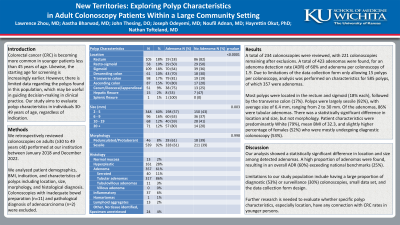Monday Poster Session
Category: Colorectal Cancer Prevention
P2106 - New Territories: Exploring Polyp Characteristics in Adult Colonoscopy Patients Within a Large Community Setting
Monday, October 28, 2024
10:30 AM - 4:00 PM ET
Location: Exhibit Hall E

Has Audio

Lawrence Zhou, MD
The University of Kansas School of Medicine
Wichita, KS
Presenting Author(s)
Lawrence Zhou, MD1, Aastha V. Bharwad, MD2, John Thesing, DO2, Joseph Odeyemi, MD2, Noufil Adnan, MD2, Hayrettin Okut, PhD2, Nathan Tofteland, MD2
1The University of Kansas School of Medicine, Wichita, KS; 2University of Kansas School of Medicine, Wichita, KS
Introduction: Colorectal cancer (CRC) is becoming more common in younger patients less than 45 years of age. Likewise, the starting age for screening colonoscopy is increasingly earlier. However, there are limited data regarding the polyps found in this population, which may be useful in guiding decision-making in clinical practice. Our study aims to evaluate polyp characteristics in individuals 30-49 years of age, regardless of indication.
Methods: We retrospectively reviewed colonoscopies on adults (≥30 to 49 years old) performed at our institution between January 2018 and December 2022. We analyzed patient demographics, BMI, indication, and characteristics of polyps including location, size, morphology, and histological diagnosis. Colonoscopies with inadequate bowel preparation (n=11) and pathological diagnosis of adenocarcinoma (n=2) were excluded.
Results: A total of 234 colonoscopies were reviewed, with 221 colonoscopies remaining after exclusions. A total of 423 adenomas were found, for an adenoma detection rate (ADR) of 60% and adenoma per colonoscopy of 1.9. Due to limitations of the data collection form only allowing 15 polyps per colonoscopy, analysis was performed on characteristics for 585 polyps, of which 357 were adenomas.
Most polyps were located in the rectum and sigmoid (18% each), followed by the transverse colon (17%). Polyps were largely sessile (92%), with average size of 6.4 mm, ranging from 2 to 30 mm. Of the adenomas, 86% were tubular adenomas. There was a statistically significant difference in location and size, but not morphology, among detected adenomas (Table). Patient characteristics were predominantly White (79%), with mean BMI of 32.3, and a slightly higher percentage of females (52%) who were mostly undergoing diagnostic colonoscopy (53%).
Discussion: Our analysis of polyps found during colonoscopy in younger individuals showed a statistically significant difference in location and size among detected adenomas. A high proportion of adenomas were found, resulting in an overall ADR (60%) exceeding national benchmarks (25%). Limitations to our study population include having a large proportion of diagnostic (53%) or surveillance (30%) colonoscopies, small data set, and the data collection form design. Further research is needed to evaluate whether specific polyp characteristics, especially location, have any connection with CRC rates in younger persons.
Note: The table for this abstract can be viewed in the ePoster Gallery section of the ACG 2024 ePoster Site or in The American Journal of Gastroenterology's abstract supplement issue, both of which will be available starting October 27, 2024.
Disclosures:
Lawrence Zhou, MD1, Aastha V. Bharwad, MD2, John Thesing, DO2, Joseph Odeyemi, MD2, Noufil Adnan, MD2, Hayrettin Okut, PhD2, Nathan Tofteland, MD2. P2106 - New Territories: Exploring Polyp Characteristics in Adult Colonoscopy Patients Within a Large Community Setting, ACG 2024 Annual Scientific Meeting Abstracts. Philadelphia, PA: American College of Gastroenterology.
1The University of Kansas School of Medicine, Wichita, KS; 2University of Kansas School of Medicine, Wichita, KS
Introduction: Colorectal cancer (CRC) is becoming more common in younger patients less than 45 years of age. Likewise, the starting age for screening colonoscopy is increasingly earlier. However, there are limited data regarding the polyps found in this population, which may be useful in guiding decision-making in clinical practice. Our study aims to evaluate polyp characteristics in individuals 30-49 years of age, regardless of indication.
Methods: We retrospectively reviewed colonoscopies on adults (≥30 to 49 years old) performed at our institution between January 2018 and December 2022. We analyzed patient demographics, BMI, indication, and characteristics of polyps including location, size, morphology, and histological diagnosis. Colonoscopies with inadequate bowel preparation (n=11) and pathological diagnosis of adenocarcinoma (n=2) were excluded.
Results: A total of 234 colonoscopies were reviewed, with 221 colonoscopies remaining after exclusions. A total of 423 adenomas were found, for an adenoma detection rate (ADR) of 60% and adenoma per colonoscopy of 1.9. Due to limitations of the data collection form only allowing 15 polyps per colonoscopy, analysis was performed on characteristics for 585 polyps, of which 357 were adenomas.
Most polyps were located in the rectum and sigmoid (18% each), followed by the transverse colon (17%). Polyps were largely sessile (92%), with average size of 6.4 mm, ranging from 2 to 30 mm. Of the adenomas, 86% were tubular adenomas. There was a statistically significant difference in location and size, but not morphology, among detected adenomas (Table). Patient characteristics were predominantly White (79%), with mean BMI of 32.3, and a slightly higher percentage of females (52%) who were mostly undergoing diagnostic colonoscopy (53%).
Discussion: Our analysis of polyps found during colonoscopy in younger individuals showed a statistically significant difference in location and size among detected adenomas. A high proportion of adenomas were found, resulting in an overall ADR (60%) exceeding national benchmarks (25%). Limitations to our study population include having a large proportion of diagnostic (53%) or surveillance (30%) colonoscopies, small data set, and the data collection form design. Further research is needed to evaluate whether specific polyp characteristics, especially location, have any connection with CRC rates in younger persons.
Note: The table for this abstract can be viewed in the ePoster Gallery section of the ACG 2024 ePoster Site or in The American Journal of Gastroenterology's abstract supplement issue, both of which will be available starting October 27, 2024.
Disclosures:
Lawrence Zhou indicated no relevant financial relationships.
Aastha Bharwad indicated no relevant financial relationships.
John Thesing indicated no relevant financial relationships.
Joseph Odeyemi indicated no relevant financial relationships.
Noufil Adnan indicated no relevant financial relationships.
Hayrettin Okut indicated no relevant financial relationships.
Nathan Tofteland indicated no relevant financial relationships.
Lawrence Zhou, MD1, Aastha V. Bharwad, MD2, John Thesing, DO2, Joseph Odeyemi, MD2, Noufil Adnan, MD2, Hayrettin Okut, PhD2, Nathan Tofteland, MD2. P2106 - New Territories: Exploring Polyp Characteristics in Adult Colonoscopy Patients Within a Large Community Setting, ACG 2024 Annual Scientific Meeting Abstracts. Philadelphia, PA: American College of Gastroenterology.
